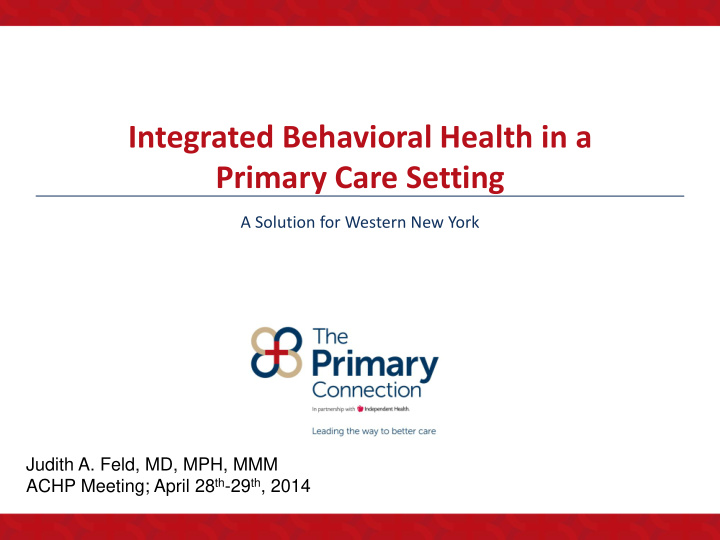



Integrated Behavioral Health in a Primary Care Setting A Solution for Western New York Judith A. Feld, MD, MPH, MMM ACHP Meeting; April 28 th -29 th , 2014
Overview • The new Primary Care: The Primary Connection • Identifying the problem and potential solutions • Pilot and Prototype Development • Pilot Overview • Program Goals/Expansion
The Primary Connection • 29 community based practices, 189 physicians in a collaborative, shared savings reimbursement model • Governance: dedicated Physician Leadership Council made up of community physicians and community leaders • Strong collaboration between primary care physician practices and other health care providers • IH as facilitator: resources and programs to assist in practice transformation and care delivery • Founded on the principles of the Triple Aim
System Concerns • 80% with a BH disorder will visit primary care at least 1X in a calendar year 1 • 67% with a behavioral health disorder do not get behavioral health treatment 2 • 30-50% of referrals from primary care to an outpatient behavioral health clinic don’t make first appt 3,4 • Two-thirds of primary care physicians (N=6,660) reported being unable to access outpatient behavioral health for their patients. PCPs cited shortages of mental health care providers, health plan restrictions, and lack of coverage as significant barriers to mental health care access 5 1. Narrow et al., Arch Gen Psychiatry. 1993;50:5-107. 2. Kessler et al., NEJM. 2005;352:515-23. 2. Fisher & Ransom, Arch Intern Med. 1997;6:324-333. 3. Hoge et al., JAMA. 2006;95:1023-1032. 4. Cunningham, Health Affairs. 2009; 3:w490-w501. 4
Provider Adoption Solutions • Change how you provide Train behavioral health ancillary professionals to deliver services as integrated members of the primary care team • Change traditional treatment patterns Basic behavioral care and mild/moderate mental illness and substance abuse will be treated in right setting at right time. High cost, scarce specialty mental health providers (psychiatrists) will work at top of license and service broad population needs • Change how you pay FFS hinders BH care delivery due to resource limitations. Move to “team reimbursement” and multi -payer agreement for psychiatric consultation.
Behavioral Health Developments Independent Health Impact Pilots (2011-2012) Amherst Peds HEAL 17 Program (2011-2013) Pilot (2012-2014) PCMH Primary Proposed Development Connection Integrated BH (2009-2012) (2012-tbd) (2013-2016) 2016 1996 Affordable Care Health Homes HARP Initiative Balanced Budget Act-Sec 1302 (2012) (2014-2016) Act (1997) (2009) Mental Health Reg. Behavioral Mental Health Parity /Addiction Health Orgs. DSM-5 (2013) Parity Act (1996) Equity Act (2008) (2011) Autism Mandate (2011) Federal and State State Federal For detail please see attached 6
Building Upon Other Models 1 2 1 2 Trained BH professional, Requires multi-payer agrmnt support regardless of payer to reimb. for pt case consult 7
Pilot Development • Partnership between Independent Health and Amherst Pediatric • Built on success of national and local BH initiatives (Impact, Diamond, CAP PC) • Ideally supported by value-based reimbursement • Reduce barriers to access behavioral health • Improves BH access in a primary care setting • Improve timeliness, quality and efficiency of care associated with BH needs • Conducive to scale and spread 8
Pilot Attributes • Community Focus • Promising prototype results • Multi-payer potential • Customized intervention - Focus on health behaviors (pain, obesity, smoking cessation)in addition to mental health and substance abuse concerns • Sustainable business model • Builds on local community efforts
Initial Findings • Clinical results – Reduction in referrals to BH specialists – Reduction in use of ED for BH needs – Slight increase in pharmaceutical usage • Financial results – Estimated to reduce BH claims of $16,400 associated with IHA members – Return on Investment estimated at 2.18 to 1 during the pilot period (9 mos) – Potential to positively impact shared savings • Practice experience / satisfaction • Patient experience / satisfaction 10
Results • Descriptive statistics suggest that the mental health integration model may have contributed to a considerable increase in on-site diagnosis rate of mental health disorders in 2012. • Additional findings: • Overall mental health diagnoses decreased from 2011-2012, but on-site diagnoses substantially increased • Well visits declined and issue-focused/sick visits increased in 2012 • Mental health-related prescriptions increased in 2012 • Mental health-related ER visits declined modestly • Overall visits to mental health providers declined • Most of the decline is due to decreased visits to psychiatrists • Visits to other providers declined very modestly 11
Model Benefits Stakeholder Benefits Primary Care Practices -Improved competency in patient management -Improve patient access, satisfaction and adherence -Population management -Cost containment -Maintain NCQA recognition as PCMH -Improve opportunities for shared savings, incentive awards -Decreased stigma Specialists - Improved coordination and collaboration with referring physician -Better medical outcomes -Support participation in alternate reimbursement models (ACOs, Capitation) -Improved patient satisfaction and adherence to care Patients in Western New York -Improved access to behavioral health care -Convenience -Decreased stigma -Improved health outcomes -Less out of pocket costs Employers -Decreased health care costs -Better employee health -Possible decrease in need for EAP Payers -Decreased health care costs -Improved capacity to integrate disease management and case management activities
Program Expansion Goals – Expand pilot demonstration – All patients to be seen – regardless of payer – Increase likeliness of adoption – Work to develop a common reimbursement model – Aligns with state’s interest in improving access to quality BH care for children and adolescents 13
Project Timeline Program Expansion Planning Implement Evaluation and Recruitment Training (Mar-Apr ation (May '16- Sustainability (Q2 2014) (Q2 2014) ‘14) (July 2014 - Aug '16) (May '16 - May 2016 ) ongoing)
Recommend
More recommend